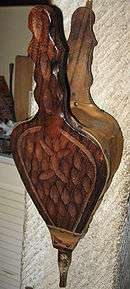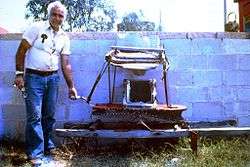Bellows
.svg.png)
A bellows or pair of bellows is a device constructed to furnish a strong blast of air. The simplest type consists of a flexible bag comprising a pair of rigid boards with handles joined by flexible leather sides enclosing an approximately airtight cavity which can be expanded and contracted by operating the handles, and fitted with a valve allowing air to fill the cavity when expanded, and with a tube through which the air is forced out in a stream when the cavity is compressed.[1] It has many applications, in particular blowing on a fire to supply it with air.

The term "bellows" is used by extension for a flexible bag whose volume can be changed by compression or expansion, but not used to deliver air. For example, the light-tight (but not airtight) bag allowing the distance between the lens and film of a folding photographic camera to be varied is called a bellows.
Name


"Bellows" is only used in plural. The Old English name for 'bellows' was blǽstbęl(i)g, blást-bęl(i)g 'blast-bag, blowing-bag'; the prefix was dropped and by the eleventh century the simple bęlg, bylg, bylig ('bag') was used. The word is cognate with "belly".[1] There are similar words in Old Norse, Swedish, and Danish, but the derivation is not certain. 'Bellows' appears not to be cognate with the apparently similar Latin follis.[1]
Metallurgy
Several processes, such as metallurgical iron smelting and welding, require so much heat that they could only be developed after the invention, in antiquity, of the bellows. The bellows are used to deliver additional air to the fuel, raising the rate of combustion and therefore the heat output.
Various kinds of bellows are used in metallurgy:
- Box bellows were and are traditionally used in East Asia.
- Pot bellows were used in ancient Egypt.
- Tatara foot bellows from Japan.
- Accordion bellows, with the characteristic pleated sides, have been used in Europe for many centuries.
- Piston bellows were developed in the middle of the 18th century in Europe. However, the double action piston bellows were utilised by the Han Chinese in ancient China as early as the 3rd century BC.
- Metal bellows were made to absorb axial movement in a dynamic condition. Often referred to as Axial Dynamics bellows types.
The manufacturing of different alloys in China often required a continuous stream of air that was able to be blown over through molten metals. The use of double-action piston bellows was described by Chinese philosopher Lao Tzu around 500 BC to produce a continuous stream of air.[2] The Han Dynasty Chinese mechanical engineer Du Shi (d. 38) is credited with being the first to use double-action piston pumps to apply hydraulic power, through a waterwheel, to operate bellows in metallurgy. His invention was used to operate piston bellows of blast furnaces in order to forge cast iron.[3] The ancient Greeks, ancient Romans, and other civilizations used bellows in bloomery furnaces producing wrought iron. Bellows are also used to send pressurized air in a controlled manner in a fired heater.
In modern industry, reciprocating bellows are usually replaced with motorized blowers.
Double-acting piston bellows
Double-acting piston bellows are a type of bellows used by blacksmiths and smelters to increase the air flow going into the forge, with the property that air is blown out on both strokes of the handle (in contrast to simpler and more common bellows that blow air when the stroke is in one direction and refill the bellows in the other direction). These bellows blow a more constant, and thus stronger, blast than simple bellows.[4] Such bellows existed in China at least since the 5th century BC, when it was invented, and had reached Europe by the 16th century.[5][6][7] In 240 BC, The ancient Greek inventor Ctesibius of Alexandria independently invented a double-action piston bellow used to lift water from one level to another.[8]
A piston is enclosed in a rectangular box with a handle coming out one side. The piston edges are covered with feathers, fur, or soft paper to ensure that it is airtight and lubricated. As the piston is pulled, air from one side enters and flows through the nozzle and as it is pushed air enters from the opposite side and flows through the same nozzle.[4]
Double-lung accordion bellows
These have three leaves. The middle leaf is fixed in place. The bottom leaf is moved up and down. The top leaf can move freely and has a weight on it. The bottom and the middle leaves contain valves, the top one does not. Only the top lung is connected to the spout.
When the bottom leaf is moved up, air is pumped from the bottom lung into the top lung. At the same time air is leaving the bellows from the top lung through the spout, but at a slower rate. This inflates the top lung. Next the bottom leaf is moved down to pull fresh air into the bellows. While this happens the weight on the top leaf pushes it down, so air keeps leaving through the spout.
This design does not increase the amount of air flow going into the forge, but provides a more constant air flow compared to a simple bellows. It also provides more even air flow than two simple bellows pumped alternately or one double-acting piston bellows.
Further applications
Fluid transfer applications
- Bellows are used extensively in hydraulic power circuits and cooling loops.
- They are an essential part of anesthesia machines.
- Bellows PTFE with cone and socket for ground glass joints.
- Cuckoo clocks use bellows to blow air through their gedackt (pipes) and imitate the call of the Common Cuckoo bird.
- Musical instruments may employ bellows as a substitute or regulator for air pressure provided by the human lungs:
- melodeon, concertina and related instruments
- Reed organ
- Pipe organ
- Musette de cour and some other varieties of bagpipes
- Harmonium and melodeon
- Portative
Expansion joint applications
The term "bellows" is used by extension for a number of applications that do not involve air transfer.
- Bellows are widely used in industrial and mechanical applications such as rod boots, machinery way covers, lift covers and rail covers to protect rods, bearings and seals from dirt.
- Bellows are widely used on articulated buses and trams, to cover the joint where the vehicle bends.
- Bellows are used in mechanical aneroids by acting as a precision indicator of pressure levels based on their lateral movement.
- Bellows tubing, a type of lightweight, flexible, extensible tubing may be used for delivery of gas or air at near-ambient pressure, as in early aqua-lung designs.
- Folding and view cameras use bellows to exclude light while allowing the lens to be moved relative to the film plane for focusing and, mainly in view cameras, to allow the lens to slide and tilt to control the image (camera movements).
- Piping expansion joint: In this application, bellows are formed in series to absorb thermal movement and vibration in piping systems that transport high temperature media such as exhaust gases or steam.
Gallery
- Urethane bellows
 A large bellows creates a mushroom cloud at the Exploratorium in San Francisco, California.
A large bellows creates a mushroom cloud at the Exploratorium in San Francisco, California.
See also
- Sylphon for uses of metal bellows in experimental physics and engineering.
References
Notes
- 1 2 3 [Oxford English Dictionary, 2nd ed: bellows]
- ↑ Rezende, Lisa (2007). Chronology of Science. Checkmark Books (published April 1, 2007). p. 24. ISBN 978-0816071197.
- ↑ Needham, Joseph (1986). Science and Civilization in China: Volume 4, Part 2. Taipei: Caves Books, Ltd., p. 370.
- 1 2 Craddock, Paul T. Early Metal Mining and Production. pp. 183-4.
- ↑ Temple, Robert K.G. (2007). The Genius of China: 3,000 Years of Science, Discovery, and Invention (3rd edition). London: André Deutsch, pp. 46-49. ISBN 978-0-233-00202-6.
- ↑ O'Doherty, Mark (November 24, 2012). Let There be Peace - Ascension to Ivisimara. p. 57. ISBN 978-1291208917.
- ↑ Baofu, Peter (2012). The Future of Post-human History: A Preface to a New Theory of Universality and Relativity. Cambridge Scholars Publishing (published May 1, 2012). p. 268. ISBN 978-1443837682.
- ↑ E. Newton, David (2012). World Energy Crisis: A Reference Handbook. ABC-CLIO (published November 5, 2012). p. 4. ISBN 978-1610691475.
Bibliography
- https://web.archive.org/web/20070919010534/http://www.archaeogate.org/egittologia/article/182/8/mersa-gawasis-red-sea-egypt-unoisiao-and-bu-2003-2004-f.html .
- Gernet, Jacques, trans. by J. R. Foster (1972): A History of Chinese Civilization, Cambridge University Press.
External links
| Look up bellows in Wiktionary, the free dictionary. |
| Wikimedia Commons has media related to Bellows. |
- Moyse - Richard J. and Clarence L. Patent-"Method of Making Bellows"- Jan. 1980 - US4325769-A-http://www.google.com/patents/US432576